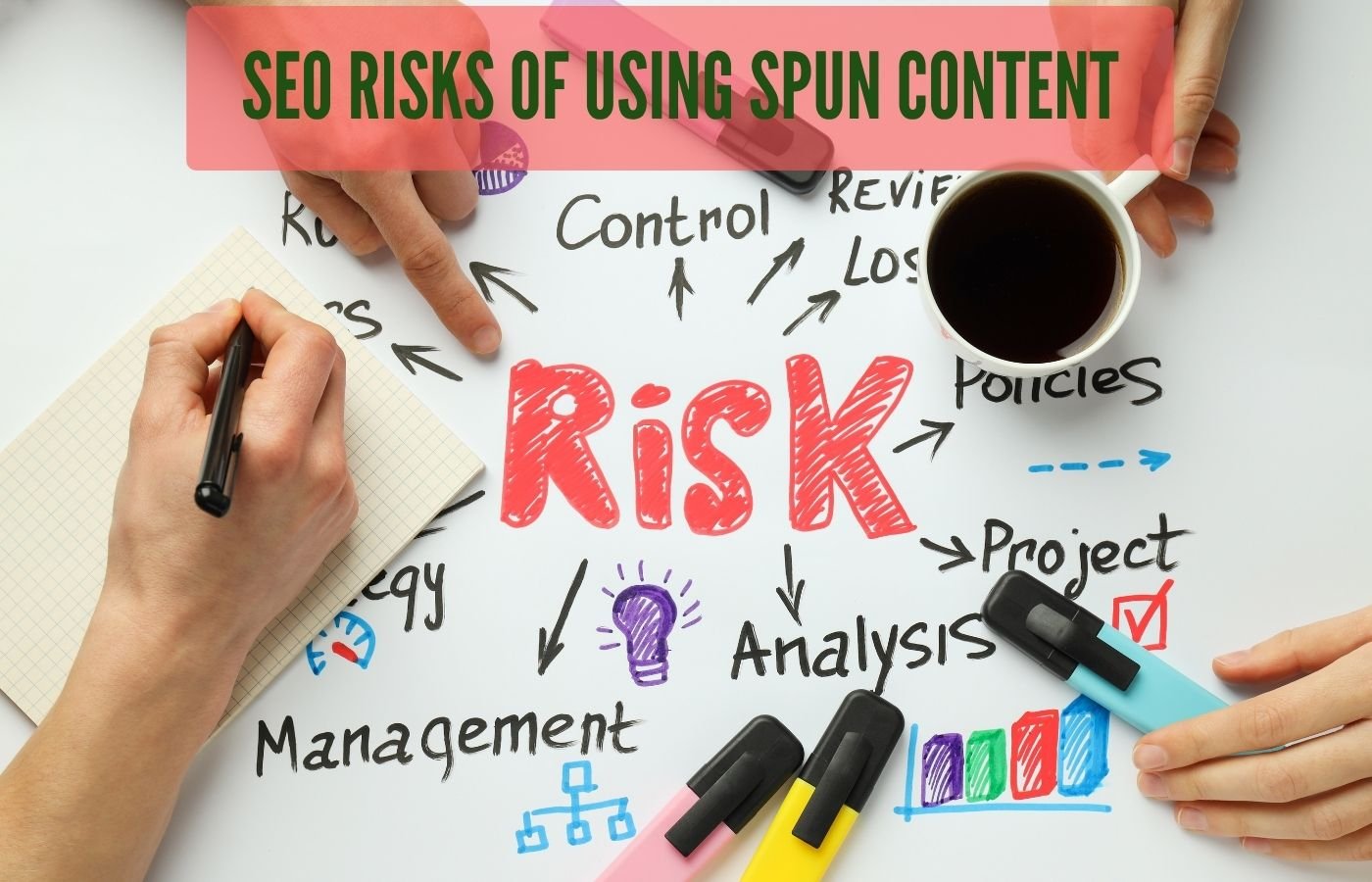SEO Risks of Using Spun Content
Spun content has become a controversial topic in the world of SEO. While it may seem like a quick and easy way to generate content, the risks associated with using spun content far outweigh any short-term benefits. In this article, we’ll take an in-depth look at the SEO risks of using spun content, why it harms your website’s rankings, and what alternatives you can consider for long-term SEO success.
What Is Spun Content in SEO?
Spun content refers to content that has been reworded or rewritten using software tools that replace certain words, phrases, or sentences with synonyms or alternate phrases. The idea behind spun content is to create new content from existing articles in an attempt to avoid duplicate content penalties by search engines like Google.
How Does Spun Content Work?
Spun content is typically created using automated tools that rewrite articles by changing words or phrases in ways that are often unnatural. These tools identify synonyms and replace them without considering the context or flow of the article. In some cases, manual spinning involves rewriting entire paragraphs, although it still runs the risk of producing low-quality content.
Is Article Spinning Legal?
Article spinning is not illegal per se, but it violates the guidelines set by search engines like Google. If content is spun excessively, or in a way that diminishes its quality, it may lead to penalties. Google’s goal is to provide users with high-quality, original content, and spinning content is seen as a shortcut that tries to manipulate the system.
The SEO Risks of Using Spun Content
1. Google Algorithm Penalties
The most significant SEO risk associated with spun content is the potential to incur penalties from Google. Over the years, Google’s algorithm has become smarter at identifying low-quality, spun content.
Google’s Panda Update
Google’s Panda algorithm was introduced to target sites with thin, low-quality content. This update specifically focuses on penalizing websites that use spun content to increase word count or fill their sites with low-value content. Spun content often lacks the depth and originality that Panda values, leading to a sharp drop in search rankings.
Google’s Penguin Update
The Penguin update focuses on web spam and unnatural link-building practices. While this update primarily targets backlinks, it indirectly impacts spun content. If spun articles are being used to generate backlinks or are linked to from other low-quality content, websites can suffer penalties.
2. Duplicate Content Issues
One of the primary SEO risks of using spun content is the creation of duplicate content. Google’s algorithms are designed to find similar or identical content across multiple websites. When you use spun content, it is highly likely that the resulting article will match other articles on the web, even if it’s slightly altered.
How Does Google Detect Duplicate Content?
Google uses sophisticated algorithms to scan the web and identify duplicate content. If your content is flagged as duplicate, Google will typically ignore the page or drop it in rankings. This can significantly harm your site’s visibility in search engine results pages (SERPs), reducing organic traffic.
3. Poor User Experience
While spun content may seem like an efficient shortcut, it often fails to meet user expectations. The writing is typically awkward, repetitive, and lacks depth. Users expect informative, engaging, and easy-to-read content that answers their queries.
How Does Poor User Experience Affect SEO?
Google’s ranking algorithms take user experience into account, considering metrics such as time on site, bounce rates, and page load speeds. If users quickly leave your site because the content doesn’t make sense or fails to provide value, it signals to Google that your content isn’t meeting their needs, ultimately harming your rankings.
4. Keyword Stuffing
Spun content often results in unnatural keyword usage or keyword stuffing. When spinning content, automated tools may insert keywords too frequently or in ways that don’t flow naturally. This practice can confuse readers and trigger Google’s algorithms to penalize your website.
What Is Keyword Stuffing?
Keyword stuffing involves overloading a webpage with a particular keyword or phrase in an attempt to manipulate search engine rankings. This practice is frowned upon by Google, and websites caught doing it often see a significant drop in rankings.
5. Damage to Brand Reputation
The use of spun content can severely damage a brand’s reputation. High-quality, original content reflects a company’s commitment to providing value to its audience. By relying on spun content, businesses risk coming across as disingenuous, unprofessional, or manipulative.
Trustworthiness and Authority
When your website’s content is poorly written or lacks substance, it’s hard to build trust with your audience. Content spinning undermines your website’s credibility and reduces the chances of converting visitors into loyal customers.
6. Reduced Organic Traffic
Spun content doesn’t contribute to long-term organic growth. While it may generate some traffic initially, the lack of quality will result in high bounce rates, lower engagement, and fewer conversions. Over time, this lack of engagement will lead to a reduction in your site’s organic traffic.
What Is Spin Writing?
Spin writing is the process of manually rewriting content to make it unique but still retain its original meaning. This practice often involves changing sentence structures and replacing words with synonyms. While spin writing is more controlled than automated content spinning, it still carries risks if done poorly.
How Spin Writing Differs from Automated Spinning
Automated spinning tools rely on algorithms to replace words and phrases, often resulting in awkward or nonsensical content. On the other hand, spin writing requires human intervention to rewrite content. Though it’s more likely to produce better quality than automated spinning, it still doesn’t compare to truly original content in terms of SEO value.
The Most Difficult Part of SEO: Creating Quality Content
Creating quality content is often considered the most difficult part of SEO. While technical SEO and backlink strategies play important roles, high-quality content is the cornerstone of any successful SEO strategy. Content is what engages users, attracts backlinks, and drives traffic.
Why Quality Content Matters
Google has become increasingly sophisticated in understanding what constitutes quality content. Content that provides real value to users, is well-researched, and is written in a natural, engaging way, is far more likely to rank well in search engines. Spun content, on the other hand, doesn’t meet these standards and risks falling into the “thin content” category.
How Spun Content Hurts Your SEO Strategy
Inaccurate or Misleading Information
Spun content often results in inaccurate or misleading information because the focus is on replacing words rather than providing factual, useful content. This can misguide readers and harm your brand’s reputation.
Lack of Engagement
Spun content is rarely compelling enough to encourage engagement. Users tend to avoid reading content that feels robotic or disconnected. Low engagement signals to Google that your content isn’t providing the value users expect, which harms your SEO efforts.
Increased Competition
When you use spun content, you’re competing with other websites that may be doing the same thing. In the end, you won’t stand out. By focusing on creating original, high-quality content, you give yourself a competitive edge in your niche.
How to Avoid the SEO Risks of Using Spun Content
Focus on High-Quality Content Creation
The best way to avoid the risks associated with spun content is to focus on creating high-quality, original content. This can include:
- Well-researched articles: Provide in-depth information that answers the reader’s query.
- Engaging writing style: Use a conversational tone that keeps readers engaged.
- Clear and concise structure: Break content into easy-to-read sections with proper headings and subheadings.
Hire Professional Content Writers
If writing high-quality content is not your strength, consider hiring professional content writers. They can create unique, engaging, and SEO-optimized content that aligns with your business goals.
Use AI Tools Responsibly
AI tools can assist with content creation, but they should be used responsibly. AI-generated content should always be reviewed, edited, and fact-checked for accuracy and quality. Avoid relying entirely on AI for content generation.
Conclusion: The Importance of Ethical Content Practices for SEO
While spinning content might seem like a quick and easy solution, it’s not worth the long-term SEO risks. From Google penalties to poor user experience, the consequences of using spun content can be detrimental to your website’s rankings and reputation.
By focusing on creating original content, following SEO best practices, and prioritizing quality over shortcuts, you can build a strong SEO foundation that drives sustainable growth. Always remember, high-quality content will never go out of style and will always give you the edge over your competitors in the long run.
This article provides actionable insights for avoiding the SEO risks associated with spun content. By investing in original content creation, businesses can avoid penalties and build lasting authority in their industry.

Raj blends SEO mastery with real-world freelance grit. From keyword to conversion, his expert writing helps readers and businesses win in today’s digital battlefield. Authentic. Sharp. Proven.

